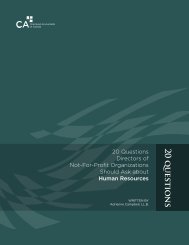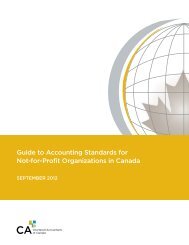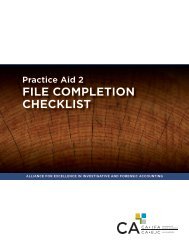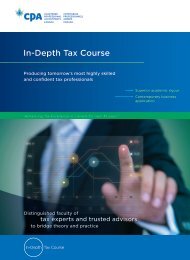20 Questions - Canadian Institute of Chartered Accountants
20 Questions - Canadian Institute of Chartered Accountants
20 Questions - Canadian Institute of Chartered Accountants
Create successful ePaper yourself
Turn your PDF publications into a flip-book with our unique Google optimized e-Paper software.
Strategic Planning y continued z8• The organization operates in a way that respects stakeholders and seeks tomeet their expectations - without letting them override the organization’svalues• The organization monitors stakeholder satisfaction on a regular basis5. How does the organization get themoney to fund its activities and programs?There are many ways to fund a not-for-pr<strong>of</strong>it organization. Each organizationshould aim to develop a funding strategy that is appropriate to its mode <strong>of</strong> operating,its mix <strong>of</strong> core program and project activities, and its funding priorities.These three types <strong>of</strong> activity each have different funding needs and opportunities– which can vary among organizations.Core activities are those that are essential to the organization’s sustainability– its capacity to exist and provide reliable delivery <strong>of</strong> its primary services. Theactivities typically include program delivery and the provision <strong>of</strong> resources tosupport them (buildings, equipment, supplies, information systems, etc). Coreactivities require the most predictable and secure funding which may comefrom such sources as endowment and investment income, membership dues,sustaining grants from governments, United Way grants, and well-establisheddonor development programs.Non-core program activities extend the organization’s capacity to provideimportant services. If necessary the organization can contract or discontinuethem and still be relevant. Non-core program activities can benefit from thesame funding sources as core activities. They may also generate their ownrevenues (fees, ticket and retail sales, etc), be eligible for special-purpose governmentgrants and secure sponsorship from businesses. In some cases, donors andsponsors may prefer to designate the support to programs rather than the organizationitself because they do not want to fund what they see as administrativeoverhead.Project activities typically address special, one-time needs that could bedeferred or cancelled if funding is not available – even though they <strong>of</strong>fer significantbenefits. They include responding to emergencies and opportunities toCore and non-coreThe difference between “core” and “non-core” is a matter <strong>of</strong>judgement. One approach is to ask “If we stopped doing this, couldwe still meet our primary objectives?”For example the core activity <strong>of</strong> a Women’s Crisis Shelter societymight be to provide emergency counseling and a safe shelter. Thesociety may also <strong>of</strong>fer related, “non-core”, services such as counselingand assistance with legal, medical, substance abuse, housing andemployment needs.Fund raisingThe competition for donations and sponsorships has become intense.Not-for-pr<strong>of</strong>it organizations are increasingly finding it necessary toengage pr<strong>of</strong>essional fund raisers - either as employees or outsideadvisors or service providers.Developing a steady flow <strong>of</strong> donations and sponsorships can be timeconsumingand expensive. It may be several years before the receiptssignificantly cover start-up and ongoing costs.improve the organization’s effectiveness – new buildings, equipment, systems,etc. Project activities may be funded from the previous sources or throughspecific appeals and grant applications. These include capital fund-raising campaigns,short-term project (or start-up) grants from charitable foundations andgovernment grants programs that match the amounts raised by organizations.In the short term, most organizations may not be in a position to change theirbasic funding model. They should, however, regularly reassess their strategiesfor raising funds because no source can be taken for granted. Many organizationshave found it necessary to find new sources <strong>of</strong> revenues as others havediminished. This may be done by adding programs designed to make pr<strong>of</strong>its,charging fees for traditionally free services or by increased fund raising fromindividual donors and businesses.

















